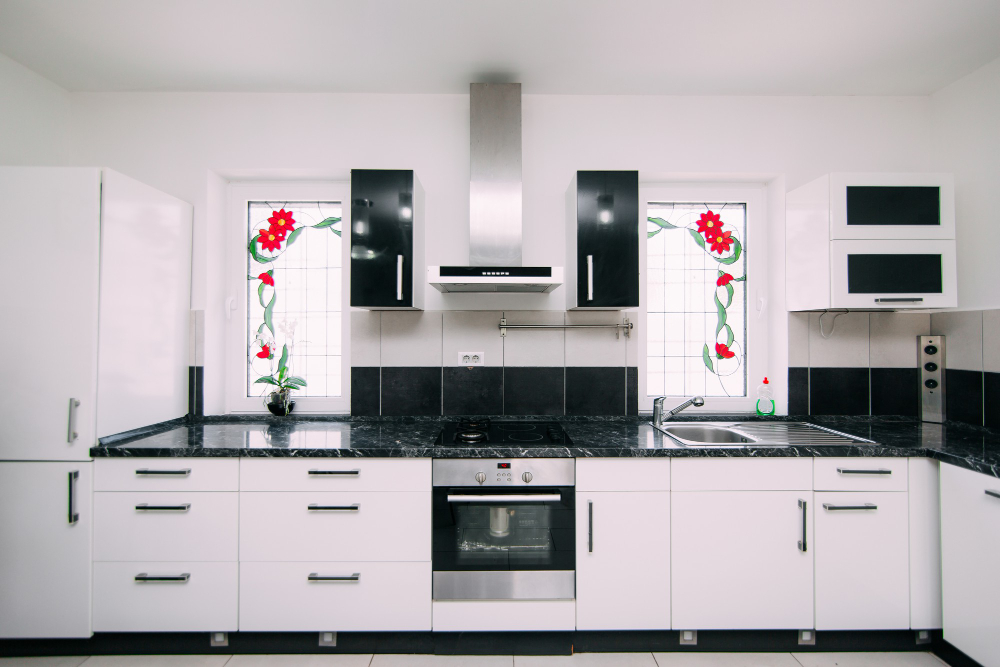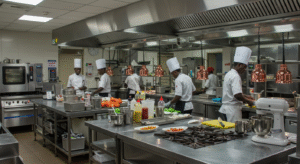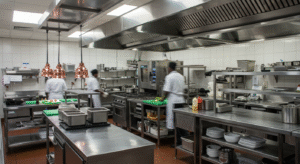How to Design an Efficient Kitchen Layout: The Ultimate Guide for Nigerian Restaurants

From Chaos to Cashflow: How to Build the Fastest, Most Efficient Kitchen for Your Restaurant
Here’s the thing: It’s not your staff. It’s not your recipe. It’s your kitchen layout.
If your kitchen isn’t arranged to flow for success, it’s silently costing you money and your peace of mind. You see it in the delayed orders, the frustrated staff, and the money wasted on inefficiency. If you’ve ever wondered why everything takes too long, this guide is your wake-up call.
After reading this article, your kitchen would transform from “I have been waiting for over 1 hour” to “I want to celebrate all my special events here because they are the fastest kitchen in Nigeria.”
Table of Contents
- Why Your Kitchen Feels Slow: The 3 Core Challenges
- The Solution: Designing Your Kitchen with Strategic Zones
- Zone 1: The Preparation Zone
- Zone 2: The Cooking Line
- Zone 3: The Packing & Service Zone
- Zone 4: The Washing Zone
- Your Equipment is Your Team: Choosing Commercial-Grade Tools
- Quick Fixes for a Faster Kitchen (Without Breaking the Bank)
- Conclusion: A Faster Kitchen is a More Profitable Kitchen
- Frequently Asked Questions (FAQ)
—–
Why Your Kitchen Feels Slow: The 3 Core Challenges
Before you can fix it, you need to know where the challenge is coming from. The “slowness” usually comes down to three issues:
- Workflow Traffic Jams: Staff members always bump into each other, often crossing paths to pick ingredients, cook, and wash the dishes. Your kitchen feels less like a professional space and more like rush hour in traffic.
- Inadequate “Consumer-Grade” Equipment: That small hand blender you got at your wedding? It wasn’t built to keep up with your customers’ demand. Using equipment not designed for commercial volume results in frequent breakdowns and poor performance.
- Disorganized Storage: If finding chicken means unpacking four cartons of beef, tin tomatoes, and plastic spoons first, you have a major storage challege. Every minute spent searching is a minute lost on cooking and serving.
The Solution: Designing Your Kitchen with Strategic Zones
The most effective kitchens in the world operate on a simple principle: workflow. Ingredients and dishes should move in one logical direction, from prep to plate, with minimal backtracking. This is achieved by creating dedicated zones.

A picture illustrating an efficient restaurant kitchen layout.
Zone 1: The Preparation Zone
This is where your raw ingredients are washed, chopped, and portioned. It should be located near your cold and dry storage.
Essential Equipment: A sturdy 6ft Stainless Steel Worktable with a Backsplash. The backsplash is very important; it reduces wastage and makes cleaning much easier. Wall-mounted shelves above the table keep daily-use seasonings and tools within arm’s reach.
Zone 2: The Cooking Line
This is the heart of your kitchen. Arrange your cooking equipment in the order it’s most frequently used to create a smooth, assembly-line process.
Essential Equipment: High-performance burners, ovens, and deep fryers. Group them to minimize movement. For example, the fryer should be next to a landing table where food can be safely drained and plated.
Zone 3: The Packing & Service Zone
For takeaway and delivery-focused restaurants, this zone is the most important. It must be clean, organized, and positioned for a quick hand-off to delivery riders or customers.
Essential Equipment: A dedicated packing table, storage for takeaway containers, and an Food Stamping Sealer to ensure that the riders do not spill the food..
Zone 4: The Washing Zone (Warewashing)
Dirty dishes should never cross paths with fresh food. Place your wash zone away from the prep and cooking areas to prevent cross-contamination, in line with HACCP principles.
Essential Equipment: A commercial Stainless Steel Sink is non-negotiable. It allows your staff to follow the correct procedure: Wash, Rinse, and Sanitize, keeping your operation hygienic and efficient.

Your Equipment is Your Team: Choosing Commercial-Grade Tools
Your tools either slow you down or speed you up. To build the fastest kitchen, you need a team of reliable, high-performance equipment.
For Storage:
Stop unpacking cartons to find one item.
- 4-Door Commercial Freezer: Organize meats, seafood, soups, and prepped items by shelf. Label everything for quick identification.
- Supermarket Shelves: Perfect for dry goods, packaging, and labels. Their open design lets you see everything at a glance.
For Processing:
- Commercial Blender: Built to handle large volumes without overheating.
- Industrial Potato Peeler: Peels a 25kg bag of potatoes in minutes, not hours. Think of the labour costs you’ll save.
Quick Fixes for a Faster Kitchen (Without Breaking the Bank)
Guess what?
You do not have to renovate yet. You only need a strategy and a few smart upgrades.
- Start with Mobile Carts: Use mobile utility carts to move heavy bags of rice, flour, or batches of ingredients. No more shouting “Make way\!” or risking back injuries.
- Embrace Wall-Mounted Shelves: Free up valuable table space by installing [3ft or 4ft wall shelves](https://www.google.com/search?q=https://afess.ng/product-category/shelving/) for frequently used spices, oils, and utensils.
- Map Your Layout: Use tape on the floor to visually map out your new zones before moving heavy equipment. Test the flow and see if it makes sense.
Conclusion: A Faster Kitchen is a More Profitable Kitchen
A slow kitchen isn’t a sign of lazy staff; it’s a sign that your space is working against you. By implementing a zoned layout and investing in the right commercial-grade tools, you can dramatically increase your speed, reduce stress, and improve your bottom line.
You can change that—without a massive budget.
If you’re ready to turn your kitchen into a well-oiled machine, we have the stainless steel tables, freezers, mixers, and impulse sealers ready for action.
Ready to upgrade? [Shop smarter at Afess.ng](https://afess.ng) or call us to speak with an equipment specialist today\!
—–
About the Author
The Afess Team is a collective of commercial kitchen experts and former restaurant operators based in Nigeria. With decades of combined experience, we understand the unique challenges of the local food industry and are dedicated to providing practical, durable, and affordable equipment solutions that help businesses thrive.
—-
Frequently Asked Questions (FAQ)
- What is the first thing I should buy to make my kitchen faster?
Start with your workflow foundation: a proper stainless steel worktable. It provides a dedicated, clean space for prep, which is the starting point for all dishes. It immediately organizes a core part of your process.
- How much space do I need between equipment?
Aim for at least 3 feet (about 1 meter) of aisle space for main pathways to allow staff to move freely and safely, even when carrying hot items. This helps prevent accidents and bottlenecks.
- Is stainless steel really necessary for my restaurant?
Absolutely. Stainless steel is non-porous, meaning it resists bacteria and is incredibly easy to clean and sanitize. It’s also highly durable and resistant to rust and corrosion, making it the industry standard for food safety and a long-term investment.